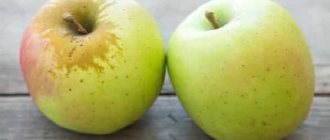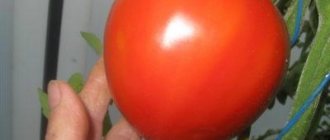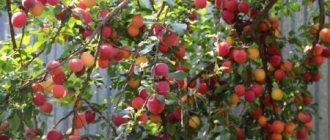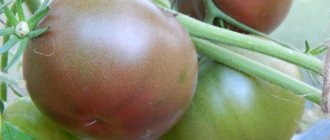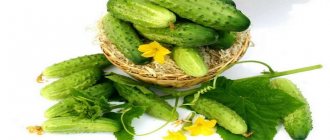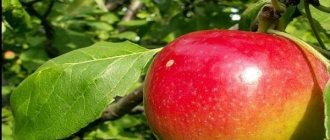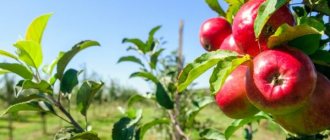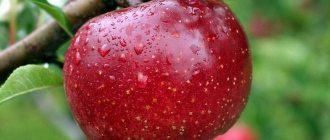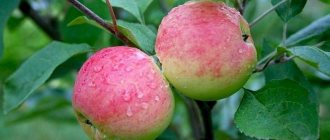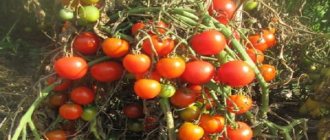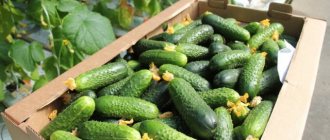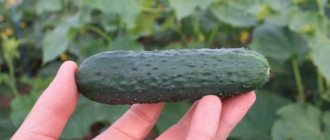One of the most common garden crops is the apple tree. For many decades, breeders have been working to create new varieties that have improved characteristics and are suitable for growing in different climatic conditions. The Belarusian sweet apple tree is one of the best late-autumn (late-winter) varieties bred at the Belarusian Research Institute of Fruit Growing. But besides this, one more variety with similar characteristics can be distinguished: Belarusian Raspberry. These two varieties are ideal for growing in temperate regions and many gardeners love them for their qualities and excellent taste of the fruit.
Description
The Belarusian sweet apple tree is a relatively new variety, but it is already gaining maximum prevalence throughout Russia. Although it was created in Belarus, already in 2005 it became a member of the State Register of the Central Region of the Russian Federation. The tree is of medium height, maximum height 3 meters. The crown is quite sparse, rounded, the branches are slightly drooping.
We are especially proud of the beautiful, even, medium-sized fruits with a regular round shape. The light, coarse-grained, rather dense pulp combines these properties as harmoniously as possible and is combined with an amazing appearance. The apple is completely sweet, without sourness, there is a light aroma. Fruit harvesting occurs in the first month of autumn, in some places even in mid-October. Under the right conditions, fruits are stored without loss of commercial quality until the end of winter.
Characteristics of the variety
The Belarusian sweet apple tree variety has a lot of declared high technical characteristics and plant characteristics. Some of them have not yet been tested experimentally, because the apple tree is very young.
Advantages and disadvantages
It is worth starting to describe the Belarusian sweet apple tree variety from a number of its undoubted advantages. These include:
- early onset of fruiting;
- high resistance to low temperatures;
- annual fruiting;
- good taste of apples;
- quite long shelf life;
- immunity to fungal diseases.
It is also worth noting the disadvantages, which can be called absolutely relative. Not everyone likes the perfectly sweet declared taste. And if apples are picked at the wrong time or incorrectly, the shelf life will be reduced.
Tree height
The variety itself is quite compact and short; it usually stops growing at 3 m. However, it does not reach this figure immediately; it slowly gains this growth over about 8 years.
An adult apple tree of this variety.
Crown width
The crown is not thickened, medium spreading, rounded, with a small number of drooping branches. Its maximum width reaches 3 m.
Productivity
From one small compact Belarusian sweet apple tree, about 35 kg of delicious ripe fruits are harvested annually. No periodicity or cyclicity was detected. For industrial cultivation, figures of 300 centners per hectare have already been declared.
Self-fertility
Another important advantage is the variety’s ability to be self-fertile. In order to receive fruiting regularly, pollinating neighbors are not needed.
Tasting assessment
The apples taste really sweet, just perfectly sweet. Therefore, the quality of fruits according to tasting has completely different indicators. If professional gardeners are inclined to score about 4 points, suggesting that the sweetness is too bland without sourness, then amateur gardeners who prefer sweet fruits give a solid five and consider the taste of the fruit to be ideal.
Winter hardiness
The apple tree's resistance to low temperatures is stated to be above average. There have already been precedents when the Belarusian sweet culture experienced a long drop in temperature to minus 35 degrees. However, these data were collected for the middle zone in which it was zoned. Although hobbyists have already introduced the variety to more northern regions, official data on the success of cultivation has not yet been confirmed.
Apple tree in winter.
Disease resistance
The Belarusian Sweet apple tree variety has absolute immunity to scab and other fungal diseases. Good immunity also ensures the apple tree’s ability to resist bark and wood diseases.
Lifespan of a tree
The declared life of the tree is about 30 years, while the fruiting period can be about 25 years. When planted on weak-growing rootstocks, as an apple tree is sometimes planted to make it even smaller, the lifespan is reduced to 25 years. It has not yet been possible to officially verify this data in Russia, because the variety has been on the State Register for just over 15 years.
Diseases and pests
This apple tree variety has stable immunity to scab. But this does not exclude the possibility of infection by other fungal diseases:
- Various kinds of spotting, late blight, alternaria - appear due to fungi of various strains. Pathogenic spores remain in foliage and soil that has not been harvested since autumn. The consequences are eliminated by cutting off diseased parts and treating with fungicides (Mancozeb helps well).
- Bacterial burn is a disease that cannot be treated. Spreads due to planting of already infected material. All that remains is to uproot the trees and treat these places with fungicidal agents.
- Powdery mildew is a fungal disease that occurs against a background of high humidity combined with prolonged heat. It is necessary to remove the affected leaves and spray the plant with “Fitoferm” or “Fundazol”.
The most dangerous insects are:
- aphid;
- mites;
- leaf rollers;
- codling moths.
For minor pest infestation, a one-time treatment with wood ash or tobacco powder is sufficient. Otherwise, potent insecticides will be required: Inta-Vir, Karbofos, Ecoberin, Zircon.
Planting and care
Although there are no particular difficulties in planting and care, you need to know some of the properties and features of the Belorusskoe sweet variety and take them into account.
Landing dates
There are two main planting periods: spring or autumn. Both dates may be suitable for a variety. When planting in autumn, you need to choose a time period at the end of September. At this time, the leaves should already have fallen, but there should still be at least 3 weeks left before frost.
Planting a young apple tree.
The most suitable time for planting in spring is usually the end of April. Then the soil is already fully warmed up, but the buds have not yet bloomed.
Technology
For proper planting, it is necessary to select in advance the place where the pit will be located. This should be a well-lit area, on a flat surface and away from groundwater. It is worth making sure that the landing site is protected as much as possible from strong winds.
To properly prepare the planting hole, it needs to be made of a suitable size, approximately one meter by one meter. At the bottom you need to put small crushed stone or small pebbles that will serve as drainage. You need to add organic matter, wood ash and mineral fertilizers to the top layer of fertile soil, mix everything and leave to ripen.
To plant a seedling, you need to form a hill of fertile soil, install the seedling, straighten the roots and install a peg for support. You need to spread the roots well, sprinkle them with soil and water them so that there are no empty spaces or air spaces. After planting, it is necessary to mulch the tree trunk circle and make sure that the grafting site is 10 cm above the ground level.
The distance between seedlings should be 5 by 3 m. And if the plant is grown on a dwarf rootstock, then you can use a 4 by 2 m scheme.
Seedling care
Starting from the first year of life, young seedlings require a little attention. They need to be watered sufficiently, preferably once every 30 days, and in severe drought conditions even once every 20 days. For the first few years of life, seedlings must be protected from strong winds and the tree trunk area insulated.
Watering an apple tree seedling with a hose.
Agricultural technology
A standard set of requirements for caring for an adult apple tree of the Belorusskoe sweet variety:
- It is necessary to water three to four times per season.
- Apple trees need to be fed two or three times according to a standard schedule.
- The tree trunk circle must be kept clean and mulched to protect it from weeds and moisture evaporation.
- Although the apple tree has high immunity, in the spring it is necessary to carry out preventive spraying to protect against pests and diseases.
Following these simple rules will help maintain the health of your apple tree.
Pruning and crown formation
Starting from the third year of life, the Belarusian sweet apple tree must be regularly pruned for sanitary purposes and to form the crown. The two procedures can be combined into one and carried out in the spring. It is necessary to remove dried, feathery and crown-thickening shoots, as well as those broken or damaged by pests.
Apple tree pruning diagram.
Pollinator varieties
The apple tree has an undoubted advantage - its self-fertility. This means that in order to produce a large amount of crop, pollinators are not required nearby or in neighboring areas.
Description of the Belarusian sweet apple tree variety: photos of apples, important characteristics, yield per tree
The variety is officially zoned only for the Northwestern Federal District, but it can be successfully grown throughout the country, right up to the Urals.
- Vologda Region.
- Arhangelsk region.
- Nenets Autonomous Okrug.
- Pskov region.
- Leningrad region.
- Karelia.
- Kaliningrad region.
- Komi.
- Novgorod region.
While the variety is very rare, it can be difficult to find seedlings. It is advisable to buy them only in nurseries, where they can provide you with complete information about the tree, its variety and biological health.
Origin
Work on the creation of the variety was carried out in the nurseries of the Belarusian Research Institute of Fruit Growing, starting in 1977. Its main creators are considered to be Evdokimenko V.M., as well as Kovalenko G.K., who introduced it to testing on farms two years later. In 1999, the variety was classified as elite, but only in 2005 was it included in the State Register and zoned.
It was based on Lithuanian Pepinka and Antonovka vulgaris. Despite the youth of the variety and unusual taste characteristics (the apple is actually sweet, with only a slight sourness in the aftertaste), it is becoming more and more popular every year.
Many inexperienced gardeners believe that the sweet taste of the fruit is a sign of a summer apple tree, the fruits of which cannot be stored for a long time. This is partly true, but there are some exceptions that you need to know. The Belorusskoye Sweet variety literally breaks all stereotypes, because it is a winter apple with a pleasant sweet taste, good winter hardiness and high productivity.
Apples: color, size, weight
The fruits of this variety are large or medium-large and can easily grow weighing 160-180 grams. They have a round shape, may be slightly lopsided, asymmetrical.
Their skin is dense, elastic, green or greenish-yellow; as it ripens, it turns yellow and becomes covered with a beautiful red or crimson blush. It can occupy either quite a large area of the fruit or very little space. There is a waxy coating on the surface that gives the apples a bluish tint.
The chemical composition can be characterized by the following indicators per 100 grams of product:
- P-active substances (catechins) – 110 milligrams.
- Ascorbic acid (vitamin C) – 10.5 milligrams.
- The amount of sugars (fructose) is 10-15%.
- Titratable acids – 0.6%.
The pulp of this variety is usually dense, with almost imperceptible graininess, very juicy, crispy, with a pleasant sour-sweet taste. In the tasting assessment, the opinions of experts differ radically. Some give Belarusian sweet only 4.1 points out of 5 possible, while others give it the maximum.
Crown and root system
The tree is of medium height, since without pruning it can reach a height of 3-3.5, and sometimes 4 meters. It has a conical crown shape when young.
Over the years, it can become very spreading, occupying at least 5 meters in diameter.
The branches are located at an acute angle, but not densely, which greatly facilitates the formation of the correct shape and harvesting in the future.
The shoots are most often green or green-brown in color; over the years they can become brown, coarse and crack. The foliage is predominantly light green, smooth, and leathery. The leaves have an oval, round, elongated shape without a sharp elongated tip.
The variety has a ringed type of fruiting, that is, apples ripen only on ringlets that form on branches over 3 years old. They age very quickly, but are replaced by new young shoots. The root system is branched and superficial.
The presence of a central core depends on the rootstock.
Productivity and pollination
The variety has a stable yield without division over the years, for which it is highly appreciated by many gardeners.
The yield is considered high, although it is usually possible to harvest no more than 35-50 kilograms of fruit from one tree. Therefore, Belarusian sweet is used very rarely for commercial intensive gardens.
The variety is completely self-fertile, therefore no other varieties are needed to produce fruit. However, experienced gardeners say that if there are any, the yields increase to 65-70 kilograms. It is good when apple trees are planted in close proximity to the apiary, so insects will have direct access to them.
Winter hardiness and disease resistance
The variety was not bred specifically for harsh conditions, but it exhibits enviable resistance to cold. When testing, apple trees tolerated frosts down to 30-36°C without much difficulty. Experiments have not yet been carried out at lower temperature conditions.
Among the main advantages of the apple tree is immunity to scab, as well as other diseases of wood and bark. True, it cannot protect trees from pests in any way. Therefore, it is recommended to regularly treat with suitable pesticides.
Subspecies and rootstocks
The variety is new, therefore it has not yet been sufficiently studied how exactly its development occurs on different rootstocks. However, some information is already available.
For example, it is clear that an apple tree on a dwarf rootstock begins to bear fruit already in the first year after planting in open ground.
Moreover, by the fifth year, it is already possible to obtain twice as much yield from it as from ordinary seed material, even after seven to eight years.
Key Features
- For this apple tree you need to choose a well-lit, sunny area, blown by all the winds. However, special care must be taken to ensure that there are no drafts. This can destroy the tree in the first year, without even allowing it to take root.
- Belarusian sweet loves moisture, but does not show resistance to dry periods, so it is a good idea to plant it where the groundwater is not very deep or even near open water bodies.
- Suitable black soil, sandy loam or loamy soil. It should be well ventilated and airy. If the black soil is too heavy and “greasy”, then it can be diluted with river sand.
- The pits are prepared in advance, at least 1-2 weeks before planting. To do this, they dig holes up to 80 centimeters deep and 1 meter in diameter, part of the soil is mixed with fertilizers and filled back in, filled with 20-30 lire of water. The pits are left in the open air. It is permissible to prepare them in the fall if spring dates are expected.
- You need to leave a distance of at least 2-4 meters between the apple tree and other plants so that later they do not conflict with their crowns and roots.
- Pegs are immediately driven into the holes on the north side, to which the seedling will be tied. Such supports can be removed no earlier than the third year of growth of apple trees.
- Immediately before planting, drainage is poured to the bottom. This could be vermiculite, broken brick, gravel or even nutshells. A seedling is placed on top of it, straightening the roots and first removing the damaged ones with pruning shears. Sprinkle with earth, lightly compacting so that the root collar protrudes at least 10-15 centimeters. If you allow the grafted cuttings to take root, then all the properties of the rootstock, for the sake of which the grafting is carried out, will be completely wasted.
- The young tree should be watered immediately with 30-40 liters of water, and the trunk area should be mulched with chopped grass or humus.
In order for the tree to quickly take root and begin to produce good harvests soon, it should be planted correctly, choosing optimal conditions for this. For the Belorusskoye Sweet variety, the best option would be to grow from seedlings two or three years old.
Disembarkation dates
You can plant this variety in the spring, before the buds open, in early or mid-April, as well as in the fall after the leaves fall in October.
However, the second option is more welcomed by experienced gardeners, since during the winter period and with the beginning of spring sap flow the apple tree will have more time to adapt to environmental conditions.
The main thing is to ensure that there are at least 4-5 weeks left before frost, otherwise the tree may freeze.
Protection from frost and rodents
In the first and second years of growth, it is better to provide seedlings with reliable protection from frost, especially if the climate in your area is quite harsh. To do this, the near-trunk circle, together with the lower part of the trunk, is covered with spruce branches or straw sheaves, hay, or you can additionally tie it with foam rubber or nylon tights.
Such piles and the tender bark of young shoots will certainly attract the attention of hungry small rodents, who willingly feast on such delicacies in winter. To scare them away, the trunks are smeared with special chemicals, melted lard or grease. Whitewashing the trunk and skeletal branches with lime helps protect against insects.
Loosening the soil, watering: proper agricultural technology
All plants love airy soil, so you need to loosen it regularly, and twice a year you need to dig in each tree well from all sides. At the same time, root shoots, shoots of bushes, other trees, and various weeds are removed.
Belarusian sweet needs to be watered regularly, at least once a month. If the weather is completely dry, you can double the frequency of watering. For one adult apple tree, use at least 50-60 liters of water at a time, and then immediately mulch the soil with humus or chopped grass or straw.
Pruning: simple crown formation
The tree tends to thicken its crown, so pruning (formative, sanitary, maintenance and rejuvenating) will need to be done regularly. It is best to do this in early spring in April or October, when the movement of sap in the trunk has already completed.
When purchasing seedlings from a nursery, pay attention to their crown. They usually have a central core and several tiered skeletal branches. If this is the case, then you won’t have to do independent pruning next year.
In the first year it is better not to injure the tree, but in the second year you can shorten the main stem by a third, and make the skeletal branches 5-7 centimeters shorter than it. You also need to constantly remove damaged shoots, dry, diseased ones, those that grow inside the crown, thickening it.
The variety is self-fertile, but additional pollinators for the cross process will only increase the yield.
Pollinators
- Antonovka.
- Pepinka.
- Cinnamon striped.
- Belarusian synap.
Reproduction
Source: https://yabloki.site/sorta-yablon/belorusskoe-sladkoe-osobennosti-sorta-i-uhoda
Features of ripening and fruiting
There are a number of important features that relate to the beginning of fruiting, harvesting, the period of removable maturity and storage of fruits.
Beginning of fruiting
The variety's early fruitfulness also does it credit. The first few apples can be obtained already in the second year after planting. Of course, there will be only a few of them, not many, but it’s enough to try. Moreover, already in the third year the amount of harvest can be maximum.
Flowering period
The apple tree opens its bright flowers in May, but it is quite difficult to name the exact date, because much depends on the climatic conditions of the region.
This is how an apple tree blooms.
Fruit ripening time
According to the timing of fruit ripening, the Belorusskoe Sladoe apple tree variety is a typical representative of winter ones. Usually the fruits are picked at the end of September or beginning of October; the period of harvesting maturity may vary slightly. However, growing regions and weather conditions make their own adjustments during the season.
Harvest and storage
If the harvest is harvested on time and undamaged, and stored under the right conditions, then you can enjoy delicious sweet apples as early as January. But official data points to consumer maturity in December.
The photo shows Belarusian sweet apples.
Harvest and storage
The fruits begin to ripen in early autumn (September-October). Timing may vary depending on the region of growth. In areas with a more severe climate, in contrast to warm zones, the beginning of ripening is earlier, it begins at the end of August.
You can eat fruits immediately after picking them, but experts say that the fruits acquire the highest taste qualities in January.
The harvest is stored well in a wooden, breathable container, in a cool and dark room. Fruits should be inspected periodically; damaged ones must be removed from the general container to prevent massive rotting.
If all conditions are met, the fruits can retain their quality until the beginning of spring.
Subspecies and options
The apple tree itself is a natural semi-dwarf and does not reach great heights. The maximum height of the tree can be 3 sometimes 3.5 m. Fruiting begins in the second or third year and lasts as stated - up to 30 years.
Belarusian sweet is also planted on a dwarf rootstock. With such planting, the first fruits can be obtained the very next year after planting.
There is one important feature of the variety. Much depends on the climatic conditions and characteristics of the growing region. The period of flowering, fruit harvesting and storage of the crop may vary. Therefore, in various sources, the Belorusskoe Sweet apple tree variety is indicated as late autumn, early winter or even late winter.
How to plant an apple tree
The holes for seedlings are prepared two weeks before planting, during which time the soil settles well. They dig them with a diameter of 1.2 m, a depth of 50-60 cm, separating the more fertile top layer, which will later be used for planting.
The dug hole is further processed. To do this, use a metal rod or shovel to loosen the bottom to a depth of bayonet height. Old tin cans, walnut shells or rusty iron are placed there, and then sprinkled with 20 cm of previously removed top soil. Fertilizers and a little wood ash are also added to the prepared pit. All this is very useful for the Belarusian Sweet tree. The apple tree variety is susceptible to fertilizing, so the result will not take long to arrive. Fertilizers are mixed with the soil, adding soil from the top layer of soil. In total, the hole should be filled to half its volume. Fertile soil is also added to the remaining part of the hole until a mound 20 cm high rises. This rule cannot be neglected, otherwise the seedling will sag. A stake is driven into the center of the formed hill - the future support for the seedling. After this, the seedling is installed, its roots are straightened and covered with fertile soil, carefully compacting it.
Since the “Belarusian Sweet” apple tree requires special nuances when planting, it is better to involve household members, neighbors or a gardener friend to help. It is imperative to tie the seedling to a driven stake in order to provide it with reliable support.
Growing in regions
Apple trees are zoned in the central region of Russia, where the climate is quite temperate. But, in addition to this region, the variety can be grown successfully in Ukraine, where the climate is very similar to the climate of its homeland - Belarus.
The nature of the Moscow region and the entire surrounding Moscow region can be quite harsh in winter. But the Belarusian Sweet apple tree variety easily endures these difficulties. You will only need to protect the plant from scab.
There is already official confirmation that the variety is successfully grown in the Urals. Of course, this only applies to the foothills, where there are no too strong colds and winds. But it will be necessary to pay attention to the condition of the apple tree throughout the season, and additionally protect it from low temperatures for the winter.
Reviews
Nina Petrovna, 28 years old, Ukraine: “I really love everything new and unusual, so I naturally bought the much-vaunted Belarusian Sweet apple tree seedling. He is only 5 years old, he is very small and compact, but he has been bearing fruit regularly for 3 years in a row. There have been no problems with the plant yet.”
Igor, 40 years old, Moscow region: “This variety is simply the best of all that I have ever encountered, without exaggeration. There are no problems with him at all. The taste and aroma are excellent. It doesn’t get sick, doesn’t freeze, and bears fruit every year. I am very glad".
Marina, 39 years old, Belarus: “This variety is very advertised here, because this is its homeland. I liked the Belarusian sweet description apples, I bought them and planted them for myself. I don't let apples sit because there aren't that many of them. I also prefer to eat them when they fall to the ground. What is not eaten goes to compote.”
Productivity
Fruit ripening begins in September and continues until November. It is possible to remove up to 37-40 kg of apples from a tree at the age of 5 years . From eight-year-old plantings, up to 16 tons are harvested per hectare. Apples do not fall to the ground when ripe.
Harvest storage
Fruits taken from the tree can be consumed immediately. Only experts assure that the maximum improvement in taste occurs by January (during storage).
When storing a slightly unripe harvest in a dark and cool room, its original properties are preserved until the end of February. If you pick ripe apples and do not follow standard storage rules, the shelf life is reduced by 2 months.
Storage conditions:
- humidity – within 75-80%;
- temperature – from 0 to +7 degrees;
- good ventilation;
- lack of light.
